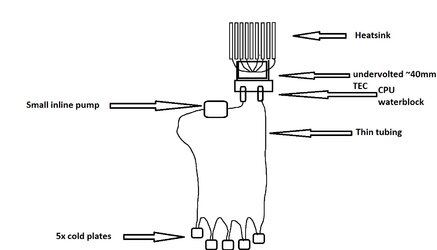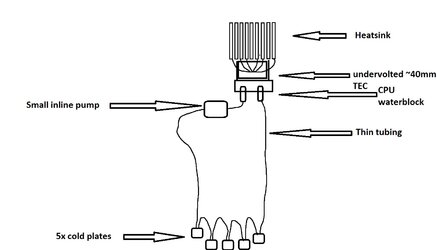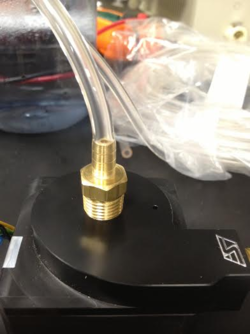- Joined
- Oct 10, 2012
- Location
- Secret lair
Is this setup still assuming that the TEC polarity will be reversed when signaled to do so? If not, which is the "real cold side," and how will the TEC heat up the water to "body temp" if the waterblock is on the "cold" side of the TEC?
Found a Swiftech MCP35X lying around! (That saves me a 100 bucks heh.)
Added a water block to my Parts List
-Water block: http://www.performance-pcs.com/cata...oduct_info&cPath=59_971_294&products_id=30144
-Radiator: http://www.performance-pcs.com/cata...t_info&cPath=59_457_667_670&products_id=21112
-Pump: Swiftech MCP35X
-1/8" ID Tygon Tubing
-1/8'' ID Copper pipe: http://www.homedepot.com/p/Cerro-1-...943611&cm_mmc=CJ-_-3754110-_-11210757&cj=true
-1/8'' barb x 1/4'' Male iron pipe size (4 of these)
i think it can be done without reversing the polarity. Either way, the watrblock remains on the hot side. It's easier
Use Radiator cooling to drop the loop temps back down to room temp.. should be fast enough. Switch TEC ON for heating, with rad fans off/low, heating should be fast. With rad fans on high, should be able to keep it steady.. if we can match the TEC & RAD. OR... with a variable voltage PSU for the TEC. Then it just turning the knob to choose the temp
If the TEC is "small" enough then a Model Train Transformator might be an option.. But TECs tend to draw some serious amps, even at only 12V. Need the TEC-specialists for exact figures.
HOWEVER, most TECs are 40mmx40mm, you NEED a waterblock with a base of at least 40x40mm, the block you listed is 15x15mm , which is fine enough if a small TEC of that size with wattage is available. I dont know where exactly the size change comes in. Most 4-5 watt TEC are 15x15mm. Where are the TEC specialists when you need them?
Last edited:




